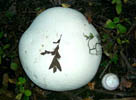(pl. substrates)
Terms discussed: -colous, corticolous, fungicolous, lichenicole, lichenicolous, lignicolous, saxicolous, substrata, terraneous, terrestrial, terricole, terricolous
The term substrate gets used in two senses. In the first place, it can refer to the substance that the fungus uses as food. The mycelium of the fungus grows through this kind of substrate, secreting enzymes that dissolve part of the substrate, and absorbing the nutrition that results. This "growing through" leads us to the second sense, which is "whatever sort of substance the fruiting body (or other visible token of the fungus) appears on." Usually, these two senses refer to the same substance, but not always.
Back to top
The other terms discussed in this entry tell you what kind of substrate you have. A lignicolous fungus has wood as its substrate. A fungicolous fungus grows on other fungi. A lichenicolous or lichenicole lichen grows on other lichens. A saxicolous lichen grows on rocks. Fungi whose fruiting bodies come up from the ground are usually called terrestrial, although you may also see any of the terms beginning with terr-. Snell actually gives the term terraneous a slightly different meaning, that of growing on dry land (as opposed, presumably, to growing underwater or in some sort of swampy situation).
Back to top
We call mushrooms terrestrial or terricolous even though no mushroom really eats dirt. Some of the " terrestrial" mushrooms are mycorhizal, and we tend not to use the word substrate at all in reference to mycorhizal mushrooms, as we assume that they get the bulk of their nutrition from their plant associates. The rest of the terrestrial mushrooms are mostly saprobes, eating miscellaneous organic debris: old leaves in the forest, old grasses in a field. They are very specific in their tastes, but (luckily for you!) we don't have specialized words (yet) to describe their predilections. So we just call them all terrestrial.
Sometimes the wood that a fungus is eating is buried (as with the roots of a stump, or the remains of a stump that has been only partially removed), so the fruiting bodies have to come up through the ground. We sometimes say that such a mushroom is "apparently terrestrial," but it may also just get called " terrestrial when growing on buried wood."
Back to top
This last is an example of a situation where a fruiting body appears on a " substrate" that is not the substance that it is feeding on. I will give three more:
First, there are some boletes whose fruiting bodies appear on wood (usually well-rotted); these fungi are probably mycorhizal (has anyone checked this?), just because all the other boletes are, so the wood that their fruiting bodies appear on is probably not their primary source of food.
Back to top
Second, saxicolous lichens grow on rocks, and even attack the rock by secreting acids that dissolve the rock (without dissolving themselves; neat trick!), but the rock is generally not considered a serious source of nutrition for the lichen. Probably it is just roughening the rock surface, or making crevices in the rock, to make it easier for the lichen to hold on.
Back to top
Third, Ramsbottom (1953) mentions behavior of honey mushrooms where on the one hand they feed on a tree (living or dead), and then send out runners to find other trees. These runners often send up fruiting bodies, and these are truly terrestrial, in the sense that they're not coming up from buried wood. Well, maybe in a sense they are, but when the buried wood can be fifty feet away, that seems to be stretching it a bit. Anyway, this is one situation where you can say that the substrate of the fruiting body (the substance that the fruiting body comes up from) is different from the substrate of the fungus (the substance that the fungus feeds on).
Back to top
Some people who want to be extra-"correct" use substrata as the plural for substrate.











